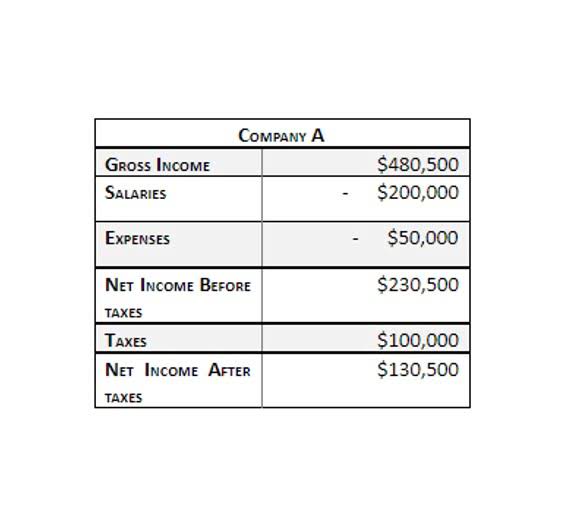Gross Income Definition TaxEDU Glossary

While we strive to provide a wide range of offers, Bankrate does not include information about every financial or credit product or service. For businesses, gross income may be positive or negative, and serves as an indicator of the company’s financial health and profitability. As noted, gross income is the starting point for calculating your tax liability.

What Counts as Gross Annual Income?
- Annual gross income is the total income generated by an individual or business before deducting certain expenses.
- Ready to understand the free Annual Income Calculator for your specific salary or hourly wages?
- But if your annual income is projected to be relatively limited, you may need to consider other business decisions.
- With a Baccalaureate of Science and advanced studies in business, Roger has successfully managed businesses across five continents.
- For an individual or business with multiple income streams or sources of earnings, their total annual income will be equal to the sum of all the income sources.
In each of our pay period structures – hourly, daily, weekly, bi-weekly and monthly – the gross annual income is $104,000. Calculating annual income for self-employed and freelance workers can be more complex due to fluctuating income streams, varied payment schedules, and the need to account for business expenses. However, understanding both your gross and net annual income is critical for budgeting, financial planning, and meeting your tax obligations. Gross income is the same as gross profit, gross earnings, or taxable income. However, the metric has different contexts for individuals and organizations.
- This may occur if the deductions claimed exceed the total income, resulting in a negative AGI.
- Conversely, if you have a fixed annual income, you can divide that by these numbers to get the respective hourly, daily, weekly, and monthly rates as well.
- Gross annual income is similar to net annual income, though there are some differences between these types of income to keep in mind.
- But this compensation does not influence the information we publish, or the reviews that you see on this site.
- Gross annual income is the amount you earn each year before any taxes or other deductions are applied.
- However, a negative AGI does not necessarily mean a refund or negative tax liability.
How to calculate annual net income
- Gross annual income includes all earnings before taxes and deductions, including salary, bonuses, commissions, and any other taxable income sources.
- Gross income shows earning potential, while net income reflects actual disposable income available for spending and saving.
- This formula allows individuals to understand their total earnings over the course of a year.
- It can better analyze what’s driving success or failure by using gross income and limiting what expenses are included in the analysis.
Use Clear button to resetThe calculator automatically multiplies your hourly rate by annual income means weekly hours and annual weeks (52) to determine yearly earnings before deductions. That tells you how much you earned the previous year, which you might use to estimate your gross and net annual income this year. Keep in mind, however, that customers are not required to send 1099s if they paid you less than $600, though you’re still required to report that income. Also, sometimes customers don’t send a 1099, such as due to an oversight, so this isn’t always the most reliable way to calculate your annual income. Gross income is the total amount of money earned in a year before taxes or other deductions get taken out. For an individual, gross income is often called “salary” or “wages” earned from a job.
Salary vs. wage
For example, if your annual income is very healthy and high, it might be time to scale up your brand and open another store. All Debt to Asset Ratio you changed was which time scale you used for the calculation. Gross net income, on the other hand, is your annual income after you deduct taxes and other expenses.
Why You Need to Calculate Your Gross Income

This is your net income and the amount you can actually take home. It may be closer to $500 or $400, depending on factors like the state you live in and if you contribute any money to a retirement account. Yes, all cash bonuses should be added to base salary when calculating gross annual income. Include performance bonuses, holiday bonuses, and any special incentives received during the tax year. Calculate average overtime hours per week, multiply by overtime rate (typically 1.5× regular wage), add to regular weekly pay before multiplying by 52. To calculate take-home pay, take your gross pay for that period and subtract the amounts your employer withheld for income taxes, payroll taxes, benefits, and deductions.
Does annual income include bonuses and overtime pay?
A paycheck is how businesses compensate employees for their work. The most common delivery schedules are bi-weekly and semi-monthly, though this varies based on employer preferences and applicable state laws and regulations. Business-specific requirements, such as collective bargaining agreements covering union employees, may also dictate paycheck frequency. Annual income refers to an individual’s yearly income as opposed to your monthly income, which is how much your income is each month. But if you do not receive paid vacation days, you will need to adjust the calculations to account for any days you took off without pay. This is why we use the average hours worked per week figure, which can be slightly lower than the typical hours worked per week alternative.

Wage garnishments

Out of the amount owed to the victim, only $175 had been paid until 2023. However, the accused agreed to pay 25-30% of his gross income to settle the large sum owed to the victim. Following health issues, the accused was released early and instructed to continue paying the fines on a monthly basis. Subtract the cost of goods sold from your total revenue to get your business’s gross income. For business owners, the first thing you need to determine is the total revenue earned by your business in a given period. Comparing a debtor’s gross income to the amount they plan to loan is called the debt-to-income ratio.

What is AGI?
Your annual income is the total amount of money you make in a single year accounting from all your income sources. This figure gives you a comprehensive view of your financial inflow for the year, helping you manage your finances and make informed decisions. It’s the starting point for creating a budget, setting financial goals, and planning for the future. For instance, let’s say that an employee’s hourly pay rate is $20.00. If the employee works 40 hours per week, the periodic pay rate on a weekly basis is $800, i.e. the employee makes $800 per week before any deductions such as taxes.
Schreibe einen Kommentar Antworten abbrechen
Recent Comments
Archives
Categories
- ! Без рубрики
- a16z generative ai
- adobe generative ai 1
- adobe generative ai 2
- articles
- bcgame5
- Bookkeeping
- Buy Semaglutide
- Buy Semaglutide Online
- Casino
- casono02123
- Credit Card Casino
- crypto casino
- Efbet Greece
- Forex News
- Forex Trading
- Lizaro Ελλάδα
- news
- no kyc casino
- Non GamStop
- oct
- oct_pb_fintechworldcup
- Pablic
- phonebazis2
- Post
- Public
- ready_text
- Semaglutide Online
- Sober living
- Uncategorized
- Up X
- up-x-on-15590-679
- Новости Форекс
- Форекс Брокеры
Theme von The WP Club . Proudly powered by WordPress